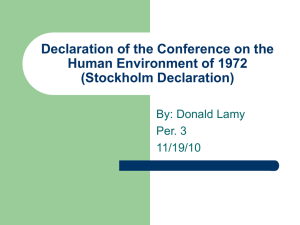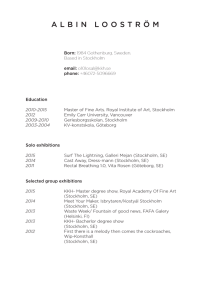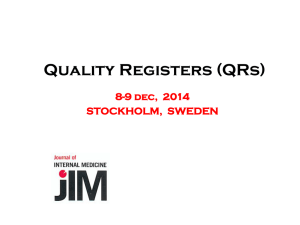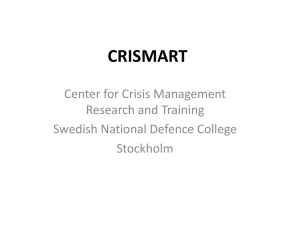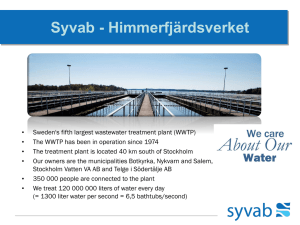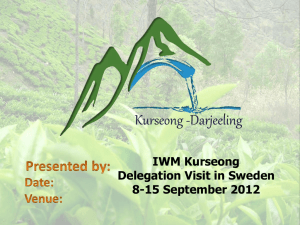Biomimetic signal processing
advertisement
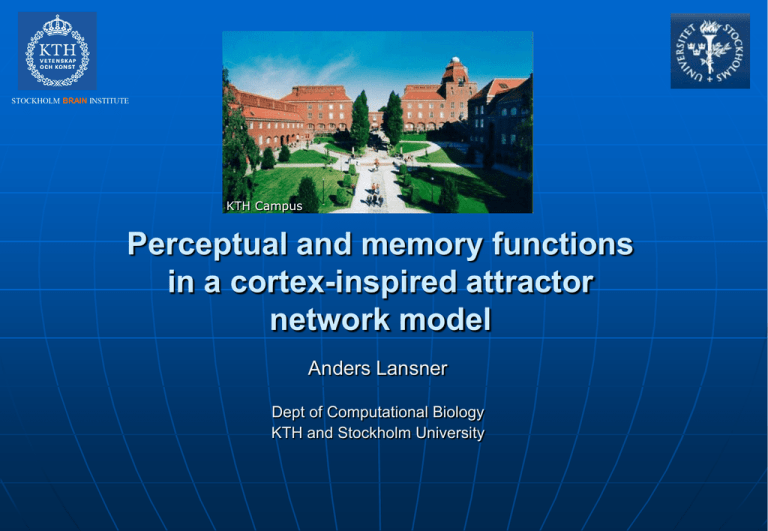
STOCKHOLM BRAIN INSTITUTE KTH Campus Perceptual and memory functions in a cortex-inspired attractor network model Anders Lansner Dept of Computational Biology KTH and Stockholm University Donald Hebb’s brain theory STOCKHOLM BRAIN INSTITUTE Hebb D O, 1949: The Organization of Behavior Bliss and Lömo, 1973 Levy and Steward, 1978 LTP/LTD, STDP, ... • • Cell assembly = mental object Gestalt perception • • Perceptual completion Perceptual rivalry • Milner P: Lateral inhibition • • After activity 500 ms • • • Figure-background segmentation Persistent, sustained Fatigue = Adaptation, synaptic depression Generalizes to associative memory • Association chains • Time-asymmetric synaptic W CNS Stockholm July 25 2011 Mathematical instanciations of Hebb’s theory STOCKHOLM BRAIN INSTITUTE • • • 1960’s-70’s Willshaw, Palm, Anderson, Kohonen e.g. Hopfield network 1982 Recurrently connected • • Layer 2/3, hippocampal CA3, olfactory cortex Sparse connectivity and activity • Human cortical connectivity (10-6) • Activity (<1%) • Modular • • Kanter, I. (1988). "Potts-glass models of neural networks." Physical Rev A 37(7): 2739-2742 Extensively studied • • Simulations, e.g. memory properties Theoretical analysis • Efficient content-addressable memory! CNS Stockholm July 25 2011 Question, outline of talk STOCKHOLM BRAIN INSTITUTE Can such an recurrent associative “attractor” memory be implemented by a network of real neurons and synapses? • If so, what relation to cortical functional architecture and what emergent dynamics? Top-down approach, complements data driven First simulations early 1980’s First journal publication Lansner and Fransén Network: Comput Neural Syst 1992 TALK OUTLINE • • • • Model network description Simulation of basic perceptual and memory function Spike discharge patterns and population oscillations Simulation of some basic ”cognitive” functions CNS Stockholm July 25 2011 From conceptual and abstract models to biophysics STOCKHOLM BRAIN INSTITUTE • Computational units? • • • • • Neuron Minicolumn Distributed sub-network Species differences? Repetitive functional modules? • Hyper/Macrocolumns • How general? Hubel and Wiesel icecube V1 model CNS Stockholm July 25 2011 Peters and Sethares 1997 Yoshimura and Callaway 2005 A layer 2/3 cortex model Microcircuit layout “Icecube - Potts” like STOCKHOLM BRAIN INSTITUTE 70% -1.5 mV 70% 1.2 mV 70% 2.5 mV 25% 2.4 mV 117% 30 pyramidal cells, connected 25% 2 dendritic targeting, vertically projecting inhibitory interneurons • RSNP, e.g. Double bouquet Hypercolumns (soft WTA modules) with • • • 0.30 mV Minicolumns/local sub-networks with • • 230% 2.5 mV Pool of Basket cells Martinotti cells, with facilitating synapses from pyramidal cells Large models: 100 minicolumns, 200 basket + Martinotti cells per hypercolumn Currently rudimentary layers 4 and 5 CNS Stockholm July 25 2011 The layer 2/3 cortex model Single cell model STOCKHOLM BRAIN INSTITUTE Hodgkin-Huxley formalism • • Na, K, KCa, Ca-channels CaAP and CaNMDA pools Pyramidal cells • 6 compartments • Inhibitory interneurons • 3 compartments • IS, soma, dendritic AP and AHP shapes Firing properties, adaptation Neuron populations • Cell size spread (±10%) Large-scale networks • • • CNS Stockholm July 25 2011 IS, soma, 1 basal, 3 apikal dendritic SPLIT simulator (by KTH) Parallel NEURON NEST simulator The layer 2/3 cortex model Synaptic properties and connectivity STOCKHOLM BRAIN INSTITUTE • Synaptic transmission • • • Local RSNP • • Distant pyramidal Synaptic targeting of soma and dendrites 3D geometry delays • • Glutamate (AMPA & voltage dependent NMDA) Depressing synapses GABAA 0.1 - 1m/s conduction speed Realistic amplitude of PSP:s in larger network models Local basket cell pre Local pyramidal post Pyramidal-pyramidal fast synaptic depression [Tsodyks, Uziel, Markram 2000] CNS Stockholm July 25 2011 Conceptual model of Neocortex STOCKHOLM BRAIN INSTITUTE Hypercolumns Cortical areas • Hypercolumns are grouped into cortical areas of various sizes • Human V1 has ~40000 hypercolumns • Human neocortex has about 110 cortical areas (Kaas, 1987) CNS Stockholm July 25 2011 Network layout STOCKHOLM BRAIN INSTITUTE One of the 9 hypercolumns 1x1 mm patch 9 hypercolumns Each hypercolumn • • Active minicolumn (30 pyramidal cells) Active basket cell Active RSNP cells CNS Stockholm July 25 2011 100 minicolumns 100 basket cells 29700 neurons 15 million synapses 100 patterns stored W trained offline (A-)symmetric 9 hypercolumns Spontaneous activity STOCKHOLM BRAIN INSTITUTE 1x1 mm patch 9 hypercolumns Each hypercolumn • • 29700 neurons 15 million synapses 100 patterns stored Non-symmetric W CNS Stockholm July 25 2011 100 minicolumns 100 basket cells 100 hypercolumns STOCKHOLM BRAIN INSTITUTE Spontaneous activity • 330000 neurons • 161 million synapses 4x4 mm CNS Stockholm July 25 2011 8 rack BG/L simulation October 2006 STOCKHOLM BRAIN INSTITUTE • • Djurfeldt M, Lundqvist M, Johansson C, Rehn M, Ekeberg Ö, and Lansner A (2008): Brain-scale simulation of the neocortex on the Blue Gene/L supercomputer. IBM J R&D 52:31-41 22x22 mm cortical patch • 22 million cells, 11 billion synapses • SPLIT simulator 8K nodes, co-processor mode • used 360 MB memory/node • Setup time = 6927 s Simulation time = 1 s in 5942 s Massive amounts of output data • 77 % estimated speedup (8K) • • • • Linear speedup to 4K nodes Point-point communication slows (?) CNS Stockholm July 25 2011 STOCKHOLM BRAIN INSTITUTE Supercomputing for brain modeling 100 ops/synapse/ms Brain simulation parallellizes very well! Neuromorphic HW ... 100 B/synapse Feb 2011 on JUGENE 12 10 Exa log(Giga) 8 • IBM Blue Gene/P CNS workshop • 294912on cores Supercomputational Neuroscience – Tools and • Spiking cortex model Applications N > 30 M Thursday• 09:00 6 Peta 4 Tera 2 • C > 300 G (Hebbian) GF Sign up on billboard! • Real time encoding and GB retreival 0 1980 1990 2000 2010 2020 2030 year CNS Stockholm July 25 2011 STOCKHOLM BRAIN INSTITUTE 2000+ neurons 250000+ synapses 5 s = 600 s on PC Interplay of Recurrent excitation Cellular adaptation Synaptic depression (Synaptic facilitation) Lundqvist M, Rehn M, Djurfeldt M and Lansner A (2006). Attractor dynamics in a modular network model of the neocortex. Network: Computation in Neural Systems: 17, 253-276 CNS Stockholm July 25 2011 Adding an interneuron with facilitating synapses STOCKHOLM BRAIN INSTITUTE Krishnamurthy, Silberberg, and Lansner 2011, submitted Silberberg and Markram Neuron 2007 CNS Stockholm July 25 2011 Bistability, raster plot formats STOCKHOLM BRAIN INSTITUTE only pyramidal cells Plot formats • Raw • Grouped Bistable • Ground state • Many active (coding) states Oscillatory Criticality? 0 1 2 3 4 seconds CNS Stockholm July 25 2011 5 6 7 Spontaneous attractor ”hopping” STOCKHOLM BRAIN INSTITUTE Synthetic LFP Frequency (Hz) 60 50 40 30 20 10 2 3 4 5 Time (seconds) 6 Memory replay at theta • Fuentemilla et al. Curr Biol 2010 CNS Stockholm July 25 2011 7 8 STOCKHOLM BRAIN INSTITUTE Stimulus during spontaneous attractor hopping Without stimulus With stimulus 0 0.5 1 1.5 2 2.5 3 Time (seconds) CNS Stockholm July 25 2011 3.5 4 4.5 5 Random long-range W? STOCKHOLM BRAIN INSTITUTE Trained W Permuted W 3.5 4 4.5 5 5.5 Time (seconds) 6 6.5 7 7.5 Cortical pairwise connection statistics obeyed in both cases CNS Stockholm July 25 2011 Stimulus during ground state + pattern completion STOCKHOLM BRAIN INSTITUTE Synthetic LFP Frequency (Hz) 60 50 40 30 20 L2/3 10 High input sensitivity From groundstate to spontaneous wandering by excitation! L4 0.4 0 1 0.5 2 0.6 0.7 3 0.8 seconds 4 seconds CNS Stockholm July 25 2011 0.9 1 5 1.1 6 1.2 7 Stimulus during ground state Modulated for persistent activity STOCKHOLM BRAIN INSTITUTE Synthetic LFP Frequency (Hz) 60 50 40 30 20 10 0 0.5 1 1.5 2 Time (seconds) 2.5 CNS Stockholm July 25 2011 3 3.5 4 Attractor rivalry STOCKHOLM BRAIN INSTITUTE 0 1 2 4 3 seconds CNS Stockholm July 25 2011 5 6 7 Hebb’s theory - summary STOCKHOLM BRAIN INSTITUTE Can be implemented with biophysically detailed neurons and synapses Basic perceptual and memory functions • • • • • Trained W Perceptual completion and rivalry Stimulus sensitivity Psychophysical reaction/processing times, 100 ms Theta, beta, and gamma power in LFP • But .... How many attractors can be stored? On-line STDP ...? ... and what about emergent dynamical properties, discharge patterns, oscillations? CNS Stockholm July 25 2011 Bistable, irregular low-rate firing, spike synchronization STOCKHOLM BRAIN INSTITUTE Lundqvist, Compte, Lansner PLOS Comp Biol 2010 Ground state Active (memory) state Balanced excitation-inhibition High CV in both states, >1 during ”hopping” 1Hz/10Hz Foreground neurons CNS Stockholm July 25 2011 Spiking activity in ground and active state STOCKHOLM BRAIN INSTITUTE • • • Ground state – diffuse Active state – focused Vm is oscillatory • Foreground neurons lead • Race condition, Fries et al. TINS 2007 • Same number of spikes in ground and active states Backgound spikes Foregound spikes CNS Stockholm July 25 2011 Oscillatory spontaneous activity STOCKHOLM BRAIN INSTITUTE CNS Stockholm July 25 2011 Rasterplot from 10000 pyramidal cells of the network. Spontaneous switching between different memory states and a non-coding ground-state attractor Alpha-Beta activity corresponds to the periods of ground state Theta, lower alpha and gamma peaks corresponds with active recall Theta – gamma phase locking STOCKHOLM BRAIN INSTITUTE Theta-gamma phase locking • e.g. Sirota et al. Neuron 2008 Attractor shift Theta+gamma – memory retrieval • Jacobs and Kahana J Neurosci 2009 • Spatial patterns of gamma oscillations code for distinct visual objects (intracranial EEG), Fig 6C -p CNS Stockholm July 25 2011 0 p 2p Bistability of oscillatory activity STOCKHOLM BRAIN INSTITUTE • • Our attractor memory model shows stable population oscillations in both ground and active state and Characteristics of in vivo cortical spiking activity • ... low rate irregular spiking of neurons • Why is this model more stable than previous ones? • RSNP inhibitory interneuron? • Large number of neurons? • Modularity - hypercolumns and minicolumns? CNS Stockholm July 25 2011 Importance of modularity STOCKHOLM BRAIN INSTITUTE Hypercolumn Basket cells Minicolumn Pyramids RSNPs Gamma phaselocking/coherence Average Vm of a minicolumn + own and external spikes No modules high Modules 0.2-0.3 NMDA less important for stability CNS Stockholm July 25 2011 Is attentional blink a by-product of cortical attractors STOCKHOLM BRAIN INSTITUTE RSVP of e.g. Letters • • Silverstein, D. and A. Lansner Front Comput Neurosci 2011 Two target letters. T1 & T2 T2 missed if too close After-activity 300-500 ms, suppressing perception of T2? Spiking H-H attractor network model Attractors stored for each item • • • T1, T2 depolarized Distractors hyperpolarized ±1 mV CNS Stockholm July 25 2011 Attentional blink results Simulation STOCKHOLM BRAIN INSTITUTE Powerful attentional modulation of target patterns by ± 1 mV Experiment Lacking ”lag-1 sparing” Benzodiazepine modulates GABA (amplitude & time constant) Boucard et al. 2000, Psychopharmacology 152: 249-255 CNS Stockholm July 25 2011 Oscillations and WM load STOCKHOLM BRAIN INSTITUTE Synaptic working memory • • • q Sandberg et al. 2003 Mongillo et al. Science 2008 Stored patterns (LTP) + fast plasticity Synaptic augmentation • • Lundqvist, Herman, Lansner 2011 J Cogn Neurosci a-b Wang et al. 2006 Presynaptic, non-Hebbian Storing 1 – 5 memories Increasing memory load • • • Decreased alpha & beta Increased theta & gamma Intracranial EEG • g Meltzer et al. Cereb Cortex 2008 CNS Stockholm July 25 2011 Conclusions STOCKHOLM BRAIN INSTITUTE • A Hebbian type associative memory can be built from real cortical neurons and synapses • • • • Many extensions and details remain to be investigated • • • • • Cortex-like modular structure, realistic sparse activity and connectivity Connects some basic perceptual and memory phenomena to underlying neuronal and synaptic processes Macroscopic dynamics, neuronal activity similar to that seen in data Complete the layers and understand their roles Develop network-of-network architecturs with feed-forward, lateral, feed-back projections Match new data on long-range connectivity Temporal dimension, sequential association, serial order Supercomputers enable brain-scale network models • • • Full size brain simulations feasible Substantial work on scalable simulators and analysis tools remains Will enable a better understanding of normal and diseased brain function CNS Stockholm July 25 2011 Acknowledgements STOCKHOLM BRAIN INSTITUTE • Early modeling studies, simulator development • • • • Later model development and analysis • • • EC/IP6/FET/FACETS • Mikael Lundqvist, PhD student David Silverstein, PhD student Pradeep Krishamurthy, PhD student Data analysis • EC/IP7/FET/NEUROCHEM Erik Fransén Per Hammarlund, Örjan Ekeberg Mikael Djurfeldt Pawel Herman, postdoc STOCKHOLM BRAIN INSTITUTE Swedish Foundation for Strategic Research Swedish Research Council and VINNOVA IBM AstraZeneca Select-And-Act CNS Stockholm July 25 2011 STOCKHOLM BRAIN INSTITUTE Thanks for your attention! CNS Stockholm July 25 2011
